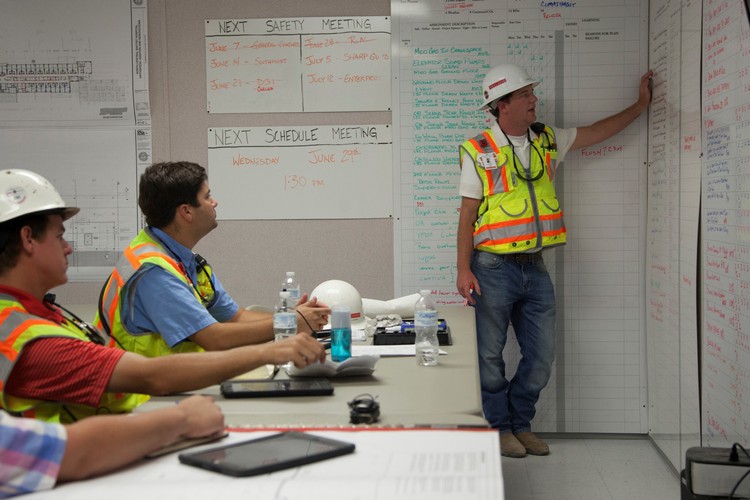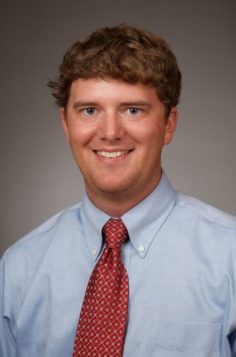
Taking ownership, building forward and giving back
By: Chris Maday Schmidt
Josh Farr is a superintendent with Robins & Morton, and has been with the company for six years. In the fifth grade, he wrote an essay describing what he wanted to do when he grew up: “I want to work in construction,” Since he graduated from Auburn University in 2012, he has consistently set records, won awards, built strong structures and strong teams. Join Construction Superintendent as Farr shares his impression of the younger, new-generation workforce; his secret to creating relationships on the job and the best piece of advice he’s received as a superintendent and how it impacts the way he does his job.
(Q) You are relatively new in the industry. How does this affect the way you approach your job, your subs, vendors and building owners?
Being young in the industry can sometimes be challenging. Many of the trade contractor’s superintendents are older and they have been “doing this a lot longer” than I have. Instead of being prideful, I take their experience and learn from it. I challenge them to come up with better ways and better flows than I have established. This gets us talking to each other and working together to come up with the best possible plan. I have also learned that this earns their trust and friendship which makes the culture on the job positive and powerful.
(Q) Did you have construction experience prior to graduating with your degree?
My construction experience began when I was 15 and I was a mason’s helper for two consecutive summers. It was just me and the mason working, so I got to build scaffold, mix all the mortar, load all the scaffolds and occasionally lay brick. After that, I went to work with the mason’s son who owned a restoration company. I helped him for two more summers, demolishing and repairing homes that had experienced fire or water damage. The most impactful experience of my career was joining the cooperative education program at Auburn University while I was in college. This gave me the opportunity to work with Robins & Morton while I was still in school. I alternated semesters, working one and going to school the next. This allowed me to gain valuable, real-life experience, connecting what I learned in textbooks to an actual building.
(Q) Talk a little about the internal continuous improvement initiative—Building Forward—that you lead for Robins & Morton. What type of coaching does this entail?
Building Forward is all about building a culture on the job that is open and collaborative. The coaching often entails teaching the utilization of several Lean construction tools, and teaching others to create a culture onsite that shows the trade contractors, architect and owner that you have their backs. When the trade contractors notice that I care about them not only as trade partners, but as people, it really changes their whole outlook on the job and me as a general contractor. We as a company have grown to understand that our most valuable people onsite are the trade contractors and the foremen over each area pushing their trade’s work. Getting them involved gives them a sense of pride in the project and recognizes them as the true driving force behind it all. Giving them a voice in the process greatly improves the job’s flow moving forward. That’s what Building Forward is all about.
(Q) What’s your impression of the younger, new-generation workforce? What types of training would you recommend for new superintendents?
As I was coming up in my career, it hit me that these buildings are not going to finish themselves. It was a turning point for me when I took it upon myself to say, “this building is mine,” started digging into the drawings and set a goal to know more about that building than anyone else. I took ownership. If I had any advice for anyone, it would be to take ownership of the building and push to know more about the job than anyone else. You can’t force someone to read drawings or read specifications. It’s a desire inside of you that says, “I want to know every detail of this building and I want to push this project to the finish.” Once you take that step, you will start to notice areas for efficiency improvement and collaborative breakdowns among the teams.
(Q) With a background in building education, entertainment and healthcare facilities, which project have you supervised that stands out most to you and why?
The project that stands out to me the most is Cherokee Indian Hospital in Cherokee, North Carolina. This project was special in many ways, not only for our company, but also in the industry. With an Integrated Project Delivery contract, all parties are involved in the project development from the time the first drawing is developed until the Certificate of Occupancy is awarded. This creates and demands a very collaborative environment. During this project, we compiled the wants and needs from each department within the hospital to make sure that each square foot was custom built for them. During the construction of the project, Robins & Morton took our Lean initiative to the next level by developing and using tools to improve our culture and onsite efficiency. We had team building events every month with the trade contractors, and I can honestly say that everyone on that project considered each other best friends. To this day, I still talk with teammates that were involved with that project.
(Q) What is your secret to creating relationships with your teams, your clients and trade partners?
The secret to developing strong relationships with each teammate is opening your mind to understand their needs and their struggles. After building different types of facilities, I’ve learned that you also have to adjust your mindset to understand the different challenges that each facility faces. When you do that to understand both the project and all parties involved, you find yourself growing to truly be a part of their team. The same goes for the trade partners. Instead of setting a schedule and demanding they meet the schedule regardless, I sit down early and often with each trade partner and try to understand what keeps them up at night. Once they open up, I take care of their issues or help them build a plan that can work with the project schedule. Once they understand that I am there to help them, they are more willing to help me when I need them to pull through.
(Q) Describe the most challenging project you’ve worked on. What did you do to overcome these challenges?
The most challenging project I have worked on was North Central Baptist Hospital’s orthopedic addition in San Antonio, Texas. That job required us to remove the exterior finishes from the front of the entire hospital and install two new elevators in the middle of the hospital’s central sterile department—although there were no elevators in this department originally. We had to hand cut, hand dig and remove concrete and dirt from the cleanest department in the facility. We also had to ensure we did not get a speck of dirt outside of our temporary walls or we would be at serious risk of infecting patients that were in surgery. Before cutting any concrete above and below these future elevators, we had to relocate main power feeds to the existing operating rooms, while also moving main mechanical ductwork feeds and the main chilled and heating water feeds that also served the facility’s operating rooms. We overcame these challenges by meeting early and often with the hospital staff and the trade contractors prior to construction, during construction and post construction. Developing relationships with the hospital staff is always crucial when impacting their facilities to this extent. Understanding their challenges and likewise getting them to understand ours kept us on the same page throughout this addition. With the trade contractors, starting early with planning, and rolling my sleeves up to investigate all of the systems with them, gave them the confidence and the feedback they needed to push the plan forward. We were all in it together from start to finish, which made it a successful project.
(Q) What is the best piece of advice you’ve received as a superintendent? How has it impacted the way you do your job?
“There’s nothing wrong with ‘I don’t know.’” This was something the first superintendent I ever worked under, David Allen, told me over and over again. This is something that I think molded my outlook on construction and decision making, ultimately helping me to get where I am today. If I am unsure of anything, I always reach out to the many resources we have on construction sites to ensure we are making the best decision for the team. Sometimes I think that pride can blind people. Once I learned that it’s okay to not know something, the pride standing in the way disappeared, allowing me to seek out the right people to ask. At the end of the job, my pride is rooted only in the fact that I know the job was built to the highest quality possible by reaching out and getting advice and suggestions along the way.
(Q) When you’re not on the jobsite, how do you spend your free time?
When not at work, I enjoy spending time with my wife. We like to get out, travel around the different areas we live and visit the surrounding cities and states. We have a goal of seeing all 50 states, which includes spending meaningful time in each state in order to check it off the list – not just passing through. We also enjoy just spending time outdoors when the weather cooperates.
(Q) Where do you see yourself career-wise in the next five, 10 and/or 15 years?
In the next five to 10 years, I still see myself traveling the country as a jobsite superintendent. I really enjoy traveling, meeting new people and getting the opportunity to build teams on different projects. One of my greatest passions at work is having a positive impact on the trade contractors. A successful job for me is when I know each trade contractor was successful and we finished the job with profit and a positive experience. Fifteen years from now, I would like to step up into a regional position where I could manage multiple project teams, teach and train them with the important lessons I have learned along the way.






 Join our thriving community of 70,000+ superintendents and trade professionals on LinkedIn!
Join our thriving community of 70,000+ superintendents and trade professionals on LinkedIn! Search our job board for your next opportunity, or post an opening within your company.
Search our job board for your next opportunity, or post an opening within your company. Subscribe to our monthly
Construction Superintendent eNewsletter and stay current.
Subscribe to our monthly
Construction Superintendent eNewsletter and stay current.